Campus myths and legends
A toast to the Tradition Stone
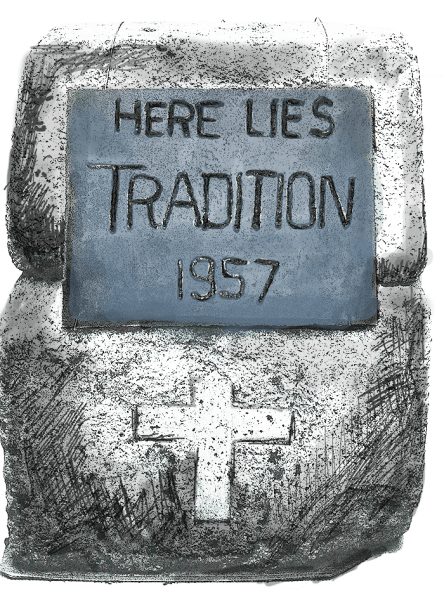
Ernest Patty ’53 (Hon.), one of the university’s original six faculty members, had a reputation as a crusader against unrefined behavior among students. He cemented that reputation in 1956 by banning alcohol, even though he said he acted not to promote good manners but to keep campus safe.
Patty revealed his taste for propriety early in the school’s history. Confronted with his mining students’ rough habits, he arranged with home economics Professor Lola Tilly ’63 (Hon.) to hold weekly teas for them.
Although Patty later resigned his faculty position in 1935 to develop a successful mining company, the UA Board of Regents hired him back as president in 1953.
At the Miner’s Ball two years later, recent School of Mines graduate Don Stein ’54 bought enough alcohol to heavily spike the punch, according to Leslie Noyes’ 2001 book, “Rock Poker to Pay Dirt.” Chaperones ignored the enhancement, as they had in previous years. The punch was smooth and strong. Students became quite intoxicated.
“Dr. Patty got a little peeved,” Stein said. “Not too long afterward, he put out a notice banning alcohol on campus.”
But Patty said a more serious incident catalyzed the ban. After a wild party in a men’s dorm, a freshman threatened to jump from a third-floor window, Patty reported in his 1969 autobiography “North Country Challenge.”
“I had had enough,” he wrote. The Nov. 30 edition of the student newspaper, The Polar Star, gave his ban a huge, single-word headline: “Prohibition!”
Student protests culminated in a vigil at Constitution Hall on March 22, 1957. They dug a hole, threw in several hundred beer bottles and planted a 400-pound headstone with a welded plate declaring “Here lies tradition.”
Patty said the protests amused him. But when the student body president carried a whiskey bottle into a dorm, “the gauntlet had been cast at my feet,” he said.
He called a student meeting, reviewed the incidents that led to the ban and said he would resign if the school lost too many students because of his policy. But “I’m not going to debate it with you,” he said. As he walked out, he wrote, “The students were all applauding and cheering.”
Patty served three more years, and the ban continued under his successor, William Wood ’89 (Hon.), until 1972, the year before Wood retired. (The Pub opened in Wood Center in 1975.)
Since the March 1957 protest, the Tradition Stone has passed through numerous hands, sometimes transferred via good-natured thievery. At some point, the stone broke into several pieces. In 1992, campus police confiscated the pieces during an unrelated investigation.
“Anxious to get rid of the stone, the university looked the other way in early 1993 when it was stolen once again,” wrote UAF history Professor Terrence Cole ’76, ’78 in his 1994 book, “The Cornerstone on College Hill.”
Megan Otts ’08, a UAF journalism student, published an article in the Nov. 4, 2007, Fairbanks Daily News-Miner documenting the stone’s recent sightings. The Sun Star said the Gay Straight Alliance had the stone in 2013 and the Sigma Phi Epsilon fraternity in 2015.
In fall 2016, the stone did not appear at Starvation Gulch festivities, where it often was spotted in past years. So, in February 2017, the UAF Student Activities Office created a flier and Facebook post asking who had it.
One Facebook commenter replied that tradition required secrecy to keep the stone “out of the hands of the university.”
Lisa Latronica, student activities coordinator, said the SAO wanted to encourage the occasional display of the stone to keep its memory alive.
“We just want all the students to be able to enjoy it,” she said.
However, she acknowledged, exposing the stone’s location would increase the risk of yet another theft. Such is tradition.
— Sam Bishop
Tip of the Top of the World
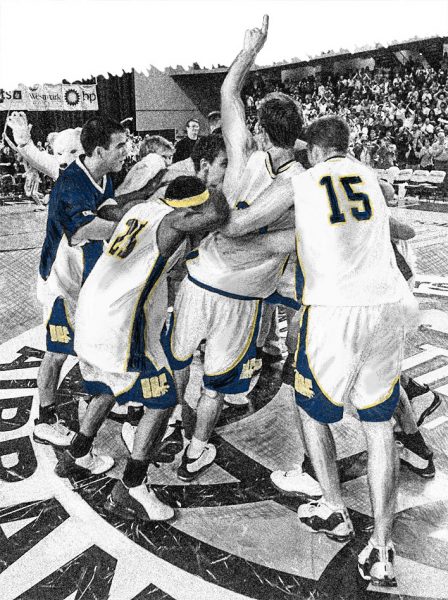
For a few days in November 2002, the Nanook men’s basketball team played out a fairytale Cinderella story before increasingly exhilarated crowds during the BP Top of the World Classic tournament. The team was about as underdog as it could be, having won just four games the previous season. Now it was up against seven Division I teams. No Division II team had ever beaten a tournament field of DI opponents before. An early-round loss was inevitable.
Until it wasn’t.
The Nanooks beat the first team handily, 78-55.
“We were playing Wisconsin-Green Bay. They didn’t take us seriously,” Al Sokaitis, the Nanooks coach at the time, recalled. “The website on their local news said we’re [Wisconsin] playing a DII school, and they’d make the most of that.”
Instead, the Nanooks made the most of Green Bay. Sokaitis knew he had a good team, but he had trepidations about their next opponent.
“Nebraska’s just huge. Their front line is 6-11, 6-11, 6-10,” Sokaitis said. “I spent most of time telling my players, ‘Oh, they’re not that big.’
“But I’m thinking to myself, ‘Damn, they’re big.’”
During the UAF-Nebraska game, tension among Nanook fans began shifting to anticipation. Instead of being blown out of the Carlson Center, the Nanooks were holding their own.
The Top of the World Classic began in 1996 and quickly became an important annual event for many sports enthusiasts in the Interior. It attracted alumni and other fans from throughout the state and even Outside.
“It was a UAF and a city of Fairbanks thing,” Sokaitis said. “I don’t know if I’ve ever in my life been a part of something where so many gave so much to make not just the event but the team successful.”
So when the Nanooks beat Nebraska 64-61, the mood in the town became electric. The underdogs were going after the top dogs.
Weber State had been undefeated in their conference the year before, while UAF had mostly lost. But now, somehow, UAF had pulled together a rhythm that seemed hard to ignore.
The game started out inauspiciously. The Nanooks didn’t take the lead until 11:21 in the first half. But after a steal by Chris Smith resulted in a bucket for Brad Oleson, the UAF team started a fire its opponent couldn’t put out. Oleson, eventual tournament MVP, scored 17 points that night, with four other Nanooks scoring in the double figures. Together, they pulled off a historic upset, beating Weber State 77-65 and becoming the only Division II school to win a Division I tournament.
“It was a perfect storm in terms of players,” Sokaitis said. “We had different personalities, from Texas, California, Alaska, and they were able to blend those differences so well. Quickness, speed, great basketball IQ, both scoring and defending.”
“When that game ended, everybody was up. Fans were up, players were up,” Sokaitis said. “I watched the crowd go crazy. It was just surreal to appreciate how far they’d come from the year before.”
— Tori Tragis
Mammoth-tusk cache remains hidden
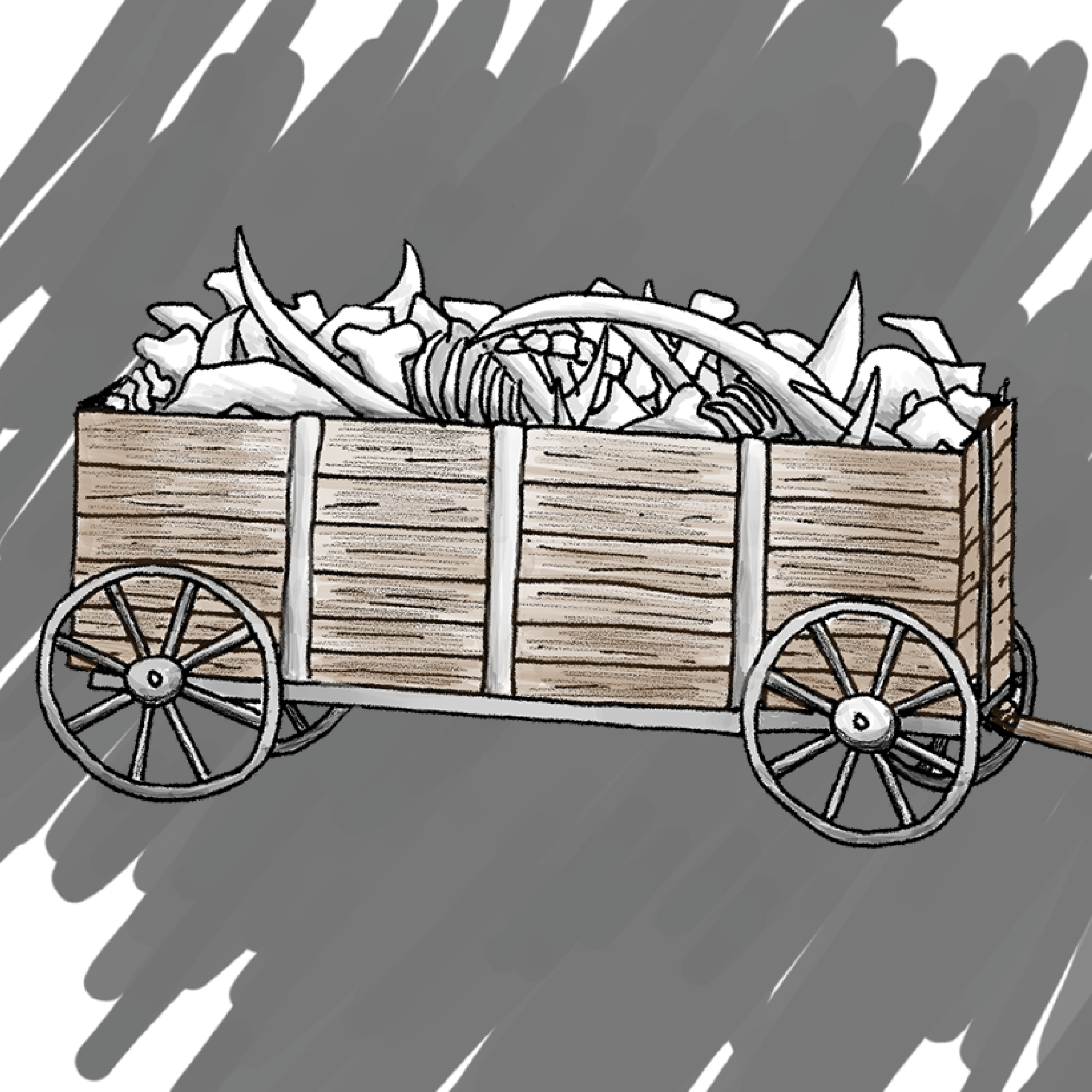
A cache of mammoth tusks lies buried somewhere on the Fairbanks campus, but the location has been lost to fading memories and the march of generations.
Tens of thousands of years ago, such tusks and their mammoth bearers were regularly buried under Interior Alaska’s windblown glacial loess.
But the mammoth tusks on campus were hidden for an entirely different reason — to protect them from thieves.
The tusks were acquired by Otto Geist ’57 (Hon.) from gold miners in the Fairbanks area.
Geist was a prominent figure in the early history of the university. He emigrated in 1910 from Germany, where he had been trained as a machinist. In America, he worked as a farmer, mechanic, soldier and trucker before heading to Alaska.
While working on a Yukon River sternwheeler in 1924, Geist met naturalist Olaus Murie and his wife, Mardy ’24, ’76 (Hon.), who had that spring become the Alaska Agricultural College and School of Mine’s second graduate.
The Muries convinced Geist to visit university President Charles Bunnell and show him some artifacts he had collected. At that meeting, Bunnell encouraged Geist to do more collecting.
In 1927, Bunnell backed the first of Geist’s many university-sponsored expeditions. Geist returned with tons of material of both human and animal origin. His collection methods later fell into disfavor because they ignored indigenous people’s interests. At the time, though, Geist was honored by some communities for his work in preserving the material.
In 1928, Geist found a new source of material. The Fairbanks Exploration Co. began washing millions of tons of muck down the creeks around Fairbanks as part of its industrial-scale gold dredging. The effort uncovered vast numbers of buried bones from Pleistocene animals, including mammoths.
The head of the F.E. Co. contacted the American Museum of Natural History, which sent a paleontologist to investigate. The paleontologist and Geist teamed up to go collecting.
“This was the beginning of the familiar ‘bone wagon’ that rattled around the Fairbanks area for years thereafter,” wrote Neil Davis ’55, ’61 in “The College Hill Chronicles,” his history of the college’s early days. “It provided summer employment to many students, often under the supervision of Otto Geist.”
The bone wagon soon overwhelmed the storage capacity of not only the college but also museums elsewhere.
“Load after interesting load of old bones came onto the campus,” Davis reported. “Piles of them grew around the buildings, and Geist even built a fence out of some of them at his off-campus home, as did at least one member of the faculty.”
With so many artifacts just lying around, Fairbanks residents began to pack them off, Davis said.
So Geist and his student crew dug a hole and buried about 30 of the tusks. As the years went by, the pit’s location was lost.
“Those tusks are still there,” said Leo Rhode ’40, former student and regent, in a 1981 interview with Davis. Rhode helped Geist bury the treasure.
“We should have put iron in with them so they could be found with a metal detector,” he said.
Davis, who completed his book in 1992, added an asterisked note to his account of the burial: “The present-day worth of the tusks, if they are in first-rate condition, probably exceeds one-half million dollars on the retail market.”
— Sam Bishop
Plane crash sparked speculation
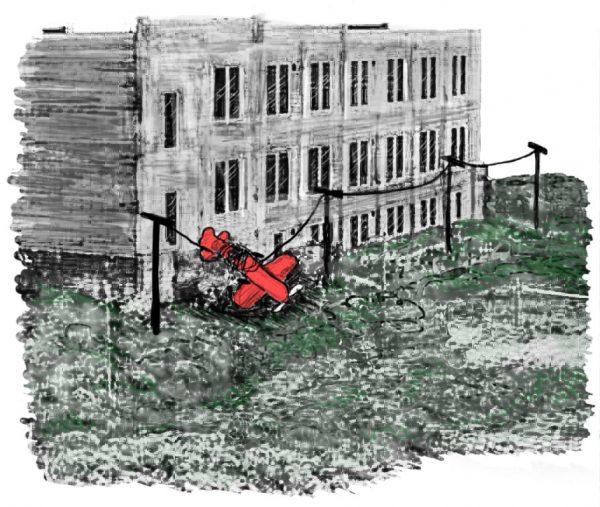
On July 12, 1944, a young soldier died when his small plane hit the Eielson Building, but his full story remains a mystery.
A group of soldiers from the medical staff at the temporary hospital in Hess Hall were playing volleyball next to the Eielson Building when the plane swooped over them.
“A minute later the players again heard the roar of an engine,” according to a Fairbanks Daily News-Miner article written years later by journalism student William King. “Shouts of annoyance suddenly changed to cries of terror when the onlookers realized that the plane was not going to be able to clear the heavy cables strung between the poles.
“Frozen in panic, the men watched the plane’s landing gear catch on the tightly strung wire, tipping the nose toward the ground and sending the whole craft hurtling just a few feet over their heads — into the base of the building. The plane telescoped into itself, and it took workmen hours to remove the pilot’s body from the wreckage.”
The News-Miner published King’s account on April 23, 1956, almost a dozen years after the incident. It was the most complete account yet, although King’s sources go entirely unnamed.
In the days following the crash, the News-Miner reported only that the young man was a student pilot and had taken off in Anchorage.
His name initially was withheld pending notification of kin, the paper said. His identity was never reported in later editions.
King did not report the name in 1956 either. The young man was a soldier, he noted.
“This [1944] was a war year. Many of the activities conducted at the university were of a confidential military nature,” King wrote. “Perhaps because of the delicacy of the situation, or because higher authority ordered a silence which since then has never been broken, the complete story never reached the public.”
King did describe an odd coincidence: The pilot’s ex-girlfriend was a student who worked in the Eielson Building. She lived on campus and planned to return to school that fall, he said.
“Although the girl was reticent about her connection with the dead flyer, she did say that she had ended their acquaintanceship, against his will, earlier in the year at Anchorage,” King wrote. She changed her plans and left Fairbanks as the summer ended that year, he said.
King did not identify the alleged ex-girlfriend. It’s not clear from his article whether he personally interviewed her or relied on secondhand accounts from people who had known her years before.
The relationship, the apparent split and the subsequent crash left unanswered questions among people who knew the details, King wrote.
“Some look upon the accident as just that — an accident due to careless flying,” King said. “The more romantically inclined see it as the final gesture of a lovesick young man killing himself at the feet of the girl who spurned him. And then there are those who, with the authority of hearsay and imagination, maintain that the young man had more than suicide in mind when he pointed the nose of the plane toward the building in which his lost love worked. … How would you have it?”
— Sam Bishop
The president who wouldn’t leave
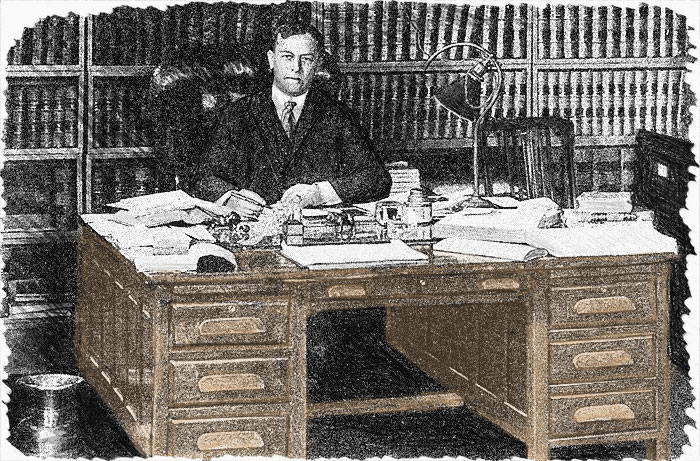
Charles Bunnell, the university’s first president, stayed in his home on campus after retiring, and he kept an office in the Eielson Building until his death seven years later. His vocal presence likely contributed to the short tenure of his successor, but no one had the heart or political support to evict him. Some wonder if his presence might still linger.
Bunnell retired on July 1, 1949, after 28 years as president. He was suffering badly from diabetes. His wife had gone Outside with their daughter almost 20 years earlier, and they had not returned.
The board hired Terris Moore ’67 (Hon.), a 40-year-old financial consultant from the East Coast, to replace Bunnell. Moore had a doctorate in business from Harvard, flew his own airplane and had climbed Denali and other Alaska peaks.
The board named Bunnell “president emeritus.” He moved from the president’s office, the Eielson Building’s Room 208, across the hall to Room 207.
“The location of the president emeritus’ office directly across from the president’s office was not a good arrangement,” wrote William Cashen ’37, a UAF math professor emeritus and university marshal, in his 1972 biography, “Farthest North College President.” “Yet to have placed Dr. Bunnell in a more remote spot or in another building would have created ill will.”
That ill will arose nonetheless.
At the May 1950 meeting, the regents voted to cut off Bunnell’s salary. The board didn’t intend to leave Bunnell penniless, according to Neil Davis ’55, ’61, a student who later became a geophysics professor. Davis, in his 1992 book, “The College Hill Chronicles,” reported that regents just wanted Bunnell to move his residence and office off campus. Few people understood that, though.
Facing public wrath, the board offered Bunnell a deal: $7,500 a year if he stayed on campus, $10,000 if he left. “Bunnell refused the higher offer, and so the board caved in,” Davis reported.
“Moore fully comprehended how devastating the current situation was to the university,” Davis wrote. “The campus could not help but remain divided into two camps as long as Bunnell wielded his influence.”
By late 1950, Davis said, Moore had resolved to leave in 1953, a schedule to which he adhered.
Moore’s successor, Ernest Patty ’53 (Hon.), reported no similar conflicts with Bunnell. That’s not surprising, given that Bunnell had endorsed Patty’s hiring and Patty had been one of the original faculty members Bunnell brought to Alaska in 1922 when the Alaska Agricultural College and School of Mines opened for classes. Patty nevertheless acknowledged, years later, the impossible situation Moore had faced.
“It was a difficult job to fill Dr. Bunnell’s shoes, particularly since the close-knit Alaska community resented [Moore] as an outsider. He had taken on a heartbreaking assignment,” Patty wrote in his 1969 autobiography, “North Country Challenge.”
Bunnell’s health failed in September 1956. He moved to California to join his daughter and died there on Nov. 1.
Bunnell’s steadfast devotion to the campus has caused some to wonder whether he might still haunt the place.
At his old home, for example? It serves today as a day care center and a lab school for childhood development students. The house, built in 1922, is the oldest structure on campus still in use.
Tina Christopher, who lived there when it was part of faculty housing in the early 1970s, told an interviewer in 2006 that her daughter once went sleepwalking outside in the winter but returned safely. She wondered if Bunnell might have had a hand in that.
“I’d like to think he sent her back home,” Christopher said. “I was always comfortable there, so if the ghost was there, he was a good, kind, gentle one who protected us.”
— Sam Bishop
The hammer and sickle prank

Political forces, a prank and a bit of sabotage converged to turn the University of Alaska’s 1951 commencement into national news.
The prank occurred when two students attempted to replace the U.S. flag with a Soviet flag during the ceremony. Newspapers across the nation published articles about the unsuccessful switch.
The attention was unsurprising, given the politics both inside and outside Alaska at the time.
In the wake of World War II, fear of the communist Soviet Union and its expansion consumed the nation. The House Un-American Activities Committee’s efforts to expose Communist Party members in Hollywood had become a high-profile matter.
In Alaska, statehood was the burning issue. So Territorial Gov. Ernest
Gruening ’55 (Hon.) brought California Gov. Earl Warren, a nationally known figure
and Alaska statehood supporter, to the 1951 commencement to receive an honorary degree.
Just as the ceremony began, someone cut a cable running from campus to the KFAR radio transmission tower on Farmers Loop. So no one heard the planned radio broadcast of Warren’s speech.
Neil Davis ’55, ’61, who was a new student on campus that year, described the details in “The College Hill Chronicles,” his 1994 history of the university’s early years.
It began when someone posted a crude Soviet flag over an Alaska map in the Main Dorm lobby. George Cunningham, an ex-Marine and successful student, took offense and ripped down the flag. Sitting nearby was Richard Haley, a disgruntled Canadian student who was being kicked out for failing grades.
“Then somehow Cunningham got caught up in the bantering discussion, which now turned toward seeking a means to use the fake Red flag in a way that would create a good joke,” Davis wrote. Both students were annoyed at how much money the administration had spent on spiffing up the campus for commencement.
The next day while the ceremony took place in the gymnasium, now Signers’ Hall, Cunningham and Haley managed to drop the U.S. colors from the campus flagpole. However, the administration had been tipped off and asked two ROTC students to watch out for trouble.
They prevented Cunningham and Haley from raising the Soviet flag. The pranksters ran off.
Initially, no media coverage of the commencement mentioned the flag incident or the cut cable.
“That could have been the end of the story were it not for Gov. Gruening,” Davis wrote.
Gruening suspected the Fairbanks Daily News-Miner, which had not yet endorsed statehood, was behind the cut wire. “He evidently contacted the News-Miner with a warning that the paper better put out some coverage,” Davis said.
Fifteen days after commencement, the News-Miner published an article about the flag incident based on a news release from UA President Terris Moore ’67 (Hon.). Wire services picked up the story and newspapers around the nation published it.
After a week of media inquiries and commentaries, Moore clarified his views in a second news release. He considered the incident a student “prank,” he said. Also, Moore said, there was no evidence that the students had cut the wire to KFAR’s transmitter.
Moore’s news release didn’t stop the outrage. Bob Bartlett ’60 (Hon.), Alaska’s delegate to Congress, asked the Un-American Activities Committee to investigate. The chairman declined, citing the committee’s busy schedule pursuing Hollywood traitors.
Both Cunningham and Haley were expelled, Davis said, but no one ever found out who cut the cable.
— Sam Bishop
Safe harbor in the ’67 flood
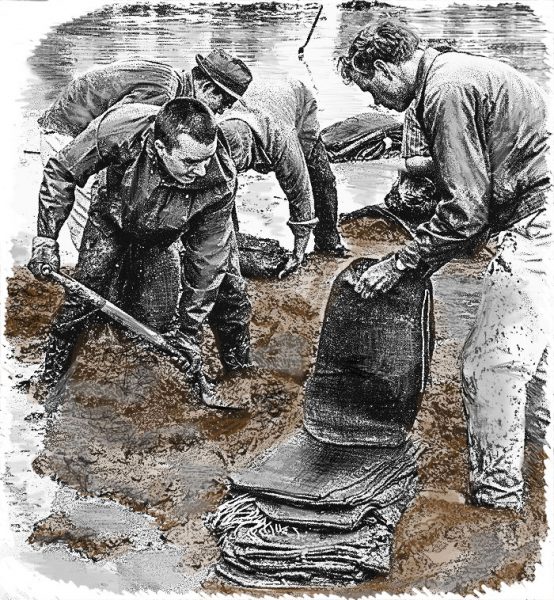
Heavy rains fell over Interior Alaska in summer 1967, and when the Chena River breached its banks on Aug. 15, it inundated much of the city. From its perch on a hill above the rising waters, the university, at the behest of President William Wood ’89 (Hon.), became a haven for thousands of Fairbanksans forced out of their homes.
More than 7,000 people sought refuge at the university.
“In less than a day the university campus grew to the size of Alaska’s fourth-largest city,” wrote Terrence Cole ’76, ’78, a UAF history professor, in his book “Cornerstone on College Hill.”
“Evacuees camped anywhere with room enough to throw a sleeping bag, in dormitories, hallways, laboratories, offices, classrooms, and closets.”
The university’s scaled-back summer catering crew suddenly needed to provide thousands of meals per day for the unexpected guests, some of whom stepped in to help the beleaguered staff. The public relations department started a bulletin, The High Water News, which became The (Lower) High Water News and The (Even Lower) High Water News.
Before the water receded, it nearly flooded the campus’ power plant. Ernest Kaiser, who attended classes and worked at UAF in the 1960s, recalled what happened in the fall 2014 issue of Aurora.
“I found the power plant superintendent, Jerry England,” Kaiser wrote. “We checked the [water] level and thought it was a bit high but not a danger to anything yet. We checked it a cup of coffee later and found it had risen almost 6 inches; at that rate of rise, it would soon be spilling into the rail coal grate at the plant and flood the lower level. If that happened, it would shut down all electrical power, heating and water.”
The men immediately made plans to build a dike around the coal, the fuel that fed the all-important boilers. A contractor loaned a bulldozer. The Army responded with electric pumps and sandbags, which were filled and stacked by some 50 volunteers from the campus’ newly expanded population.
Kaiser said the water nearly flooded the pumps but subsided with just 6 inches to spare. “Except for the volunteers filling and stacking sandbags, not many people found out how close to real disaster we came.”
The situation was dire throughout the immediate area. The fall semester hadn’t started yet, so most university students and many faculty weren’t on campus, or only in a limited way. Some students were working or vacationing outside Fairbanks and couldn’t get back into town. Professor Rudy Krejci was in Fairbanks at the time, but his home on Ballaine Road, just north of campus and above the flood waters, became its own kind of crisis center.
“We had about 25 people who escaped from downtown and moved into our house,” said Krejci, now a professor emeritus. “I was at the university, too, but I paid more attention to the refugees in my house. Going to town for food for 25 people — you run out of food for 25 people very fast.”
— Tori Tragis
Concrete mysteries
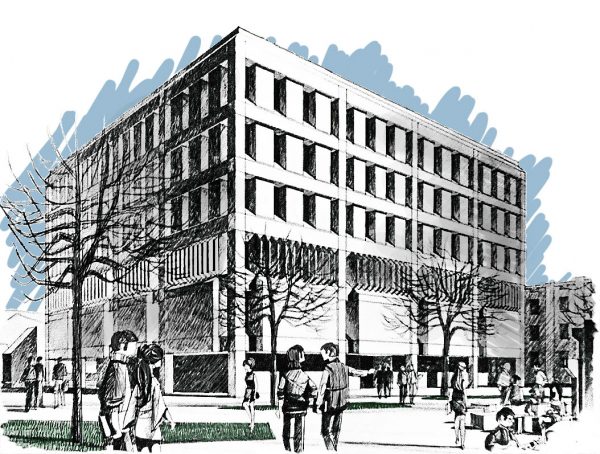
It’s hard to say which inaccuracy about the Gruening Building is the most persistent. It might be the mispronunciation of its name. Or it might be the legend that the building was designed to withstand an assault from marauding students intent on upending The System.
Let’s start with the name itself: It’s “greening.” Yes, the letters “ue” make most English speakers think of “blue” and “glue,” but stop. This time, “ue” gets the “ee” treatment — like, well, “treatment,” or “creek.”
Brian Rogers, chancellor emeritus of UAF, was very clear on this matter in a 2013 documentary made by journalism Associate Professor Rob Prince and his students.
(Rogers has his own history with UAF. He attended UAF in the 1970s and served on the University of Alaska Board of Regents in the 1990s and 2000s before being UAF’s chancellor 2009-2015.)
Concerning his qualifications to recommend a pronunciation, Rogers phrased it modestly in the documentary: “I know a little bit about the family.” In fact, Rogers worked in the 1970s as a legislative aide to Clark Gruening, the grandson of the man for whom the Gruening Building was named.
A strong supporter of statehood, Ernest Gruening ’55 (Hon.) was the territorial governor from 1939-1953, and Alaskans sent him to the U.S. Senate from 1959-1969. Gruening packed a lot into one life. He was born in New York City in 1887. He got a medical degree from Harvard in 1912 but never practiced medicine, and instead became a journalist. He also became a Democrat, and, eventually, an opponent of the Vietnam War.
This is where the second persistent myth about the Gruening Building comes into play. The building was dedicated in 1972 during a period of unrest and civil disobedience on many U.S. campuses.
It’s not uncommon to hear that its design, with its tall narrow windows and towering height (it remains the tallest building on the Fairbanks campus), would give university personnel a safe place from which to repel attacking students.
Yet Gruening himself was hardly a proponent of force, and allegedly said quietly after the building’s dedication, “Don’t they know I’m a dove?”
The building certainly looks like a fortress. It was built in what’s called the Brutalist style, all sharp angles and gray concrete. But if those narrow windows look like prime sniper positions, as some people say, wouldn’t it be better if they could actually open?
Rogers said he heard a different explanation for the windows — that they were a last-minute change to the architectural design, which had originally allowed for no windows at all. After all, it’s always dark in Fairbanks, so why would anyone need windows?
No one has found evidence that the architects intended for the Gruening Building to convert from classroom to citadel. It was more likely a reflection of the times that became a plausible explanation for later generations of students and employees to tell new arrivals.
Given the numbers of students who pass through its doors — it’s virtually impossible to get a degree in Fairbanks without taking at least one class there — there’s a lot of hand-me-down legend going on. Baffled by the building’s name and design, people talk to each other, telling each other stories about their shared history, even if that history tends a little toward fable.
— Tori Tragis
Chaos at the top
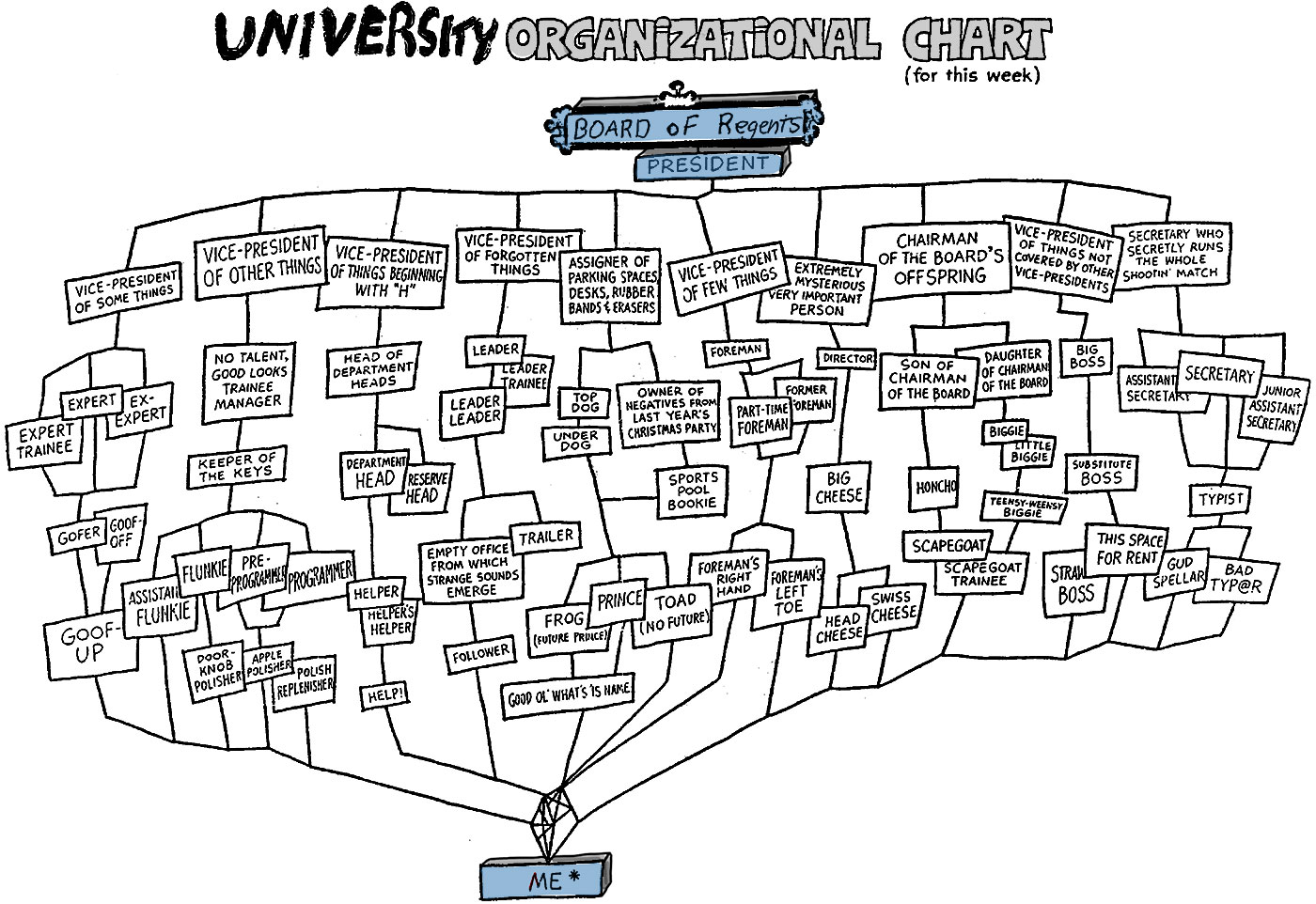
Some called it “The Year of Four Emperors.” The reference wasn’t to ancient Rome but rather to the university in 1977. Four presidents or acting presidents led the institution within a single 12-month period.
The turmoil reflected the conflict among regents, administrators, faculty, staff and students as the university tried to figure out what it should be and how to get there.
From the 1950s through the 1970s, the Fairbanks-based university had branched out into community colleges and four-year programs elsewhere in the state. Oversight of these various programs bounced from one Fairbanks administrator to another.
An accreditation team reviewed the university in October 1974 and “found ‘confusion’ and ‘uncertainty’ on reporting lines, areas of authority, etc.,” according to Kathleen Stewart’s 1984 master’s thesis on the situation. “There was an ‘urgent need for a master plan.’”
In late 1974, UA President Robert Hiatt announced such a plan. The campuses in Fairbanks, Anchorage and Juneau would be led by individual chancellors. Hiatt would retain overall authority as statewide president. Howard Cutler became the first chancellor of the “University of Alaska, Fairbanks” in 1975. But the new plan didn’t solve the university’s problems.
The Anchorage Community College teachers went on strike in mid-1975. In 1976, Sen. Chancy Croft, D-Anchorage, introduced a bill to break the community colleges away from the university entirely.
At the same time, the university introduced a new payroll system.
“Payroll, which affects everybody, was a disaster,” Stewart reported in her thesis. “In the first two-week pay period of July [1976], 800 checks had to be issued by hand. By the following payday, the system had improved to the point where approximately 358 were manually written.”
Then, in January 1977, Alaskans learned that the university had overspent its budget by millions of dollars. That started a cascade of presidential firings and hirings.
“Revelation of deficits (whether ‘real’ or the product of bad accounting software implementation) forced the resignation of President Hiatt in February,” wrote Will Jacobs, a University of Alaska Anchorage professor emeritus of history, in his 2014 book, “Becoming UAA, 1954-2014.”
Regents hired Juneau’s Chancellor Charles Ferguson as interim president. In September 1977, Neil Humphrey became president. He lasted four months.
“Humphrey later admitted that the UA’s financial affairs were in such a mess that he feared criminal indictments might soon be brought against top university officials,” reported history Professor Terrence Cole ’76, ’78 in “The Cornerstone on College Hill.”
In the meantime, in late 1977, the UA Board of Regents formally approved the full reorganization begun by Hiatt three years earlier. The basic blueprint was similar to today’s, with three main campuses in Fairbanks, Anchorage and Juneau. However, the community colleges and Cooperative Extension Service were placed in a separate division under state administration until a 1987 reorganization returned them to the campuses.
President Humphrey left in early 1978. Regents tried to hire a finalist from an earlier search, but that candidate turned them down. So regents appointed Foster Diebold, the board’s executive secretary, as interim president — the university’s fourth chief executive in less than a year.
Diebold served for 16 months until Jay Barton ’84 (Hon.) became president in 1979. Barton finally froze the revolving door — he stayed five years.
— Sam Bishop
An escalating controversy ended in stairs
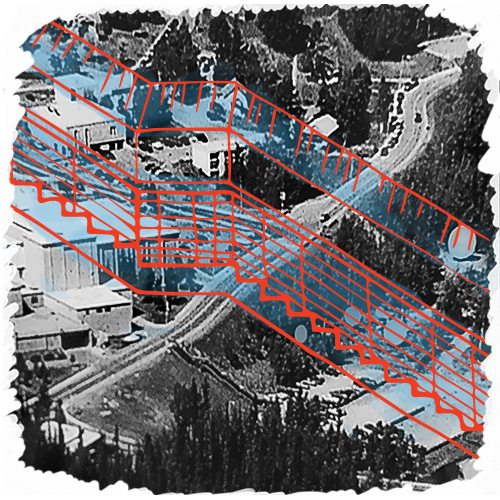
Drop down two stair flights in a hallway off the northeast corner of the Regents’ Great Hall and you arrive at a dead end. A set of locked double doors blocks the corridor.
Instinct would tell you, correctly, that the corridor once continued beyond this point.
During the 1970s and 1980s, a regular stream of pedestrians used the passageway because it was the most direct route from the Great Hall to the Ballaine parking lot. The tunnel passed under Tanana Loop and popped out of the hillside about 40 feet above the lot. From there, a set of covered wooden stairs completed the connection to the parking area.
By the mid-1980s, though, the wooden timbers that supported the tunnel had begun to deteriorate, so the university closed the tunnel. The stairway, which also was suffering, was extended to the top of the hill, where people would then cross Tanana Loop to reach the Fine Arts Complex.
The pedestrians were not pleased. So Chancellor Joan Wadlow and university planners proposed to upgrade the route with a new tunnel — and an escalator.
The proposal, with its price tag of almost $3 million, drew howls of derision. The idea was floated at a time when the university’s budget, like that of most state agencies, was suffering from the extended slump in oil prices that began in 1986. The Legislature was pondering cuts that were likely to eliminate almost 50 positions and about 160 courses. To propose an escalator during such lean times appeared out of touch to many.
Others defended the idea, though. Theater- and concert-goers from the community tended to be elderly, they noted, and an escalator would greatly ease their access to the venues.
Wadlow withdrew the escalator proposal in December 1992.
“The campus and Fairbanks communities have spoken,” Wadlow said in a prepared statement. “The time is not right.”
The escalator was never built, and the tunnel never reopened. The stairs eventually were removed.
To maintain access to the Ballaine and Taku lots, the university instead installed a sidewalk and handrail along Taku Drive in 2002. The steep slope, often icy, was dubbed “Bobsled Hill.” So, in 2015, the university replaced the sidewalk and rail with an elevated staircase of metal grates along Taku Drive.
Today, only a few shrubby willows mark the old tunnel’s mouth on the hillside above
the Ballaine parking lot.
The situation still could change someday, though. The university’s 2010 Campus Master
Plan lists construction of a parking garage on the Ballaine lot as a “long-term priority.”
An artist’s rendering shows a five-story garage with an enclosed, elevated walkway
from its roof to the Fine Arts Complex.
— Sam Bishop



